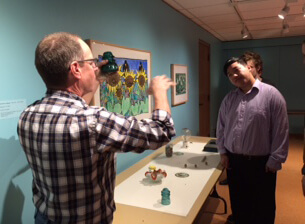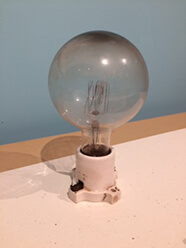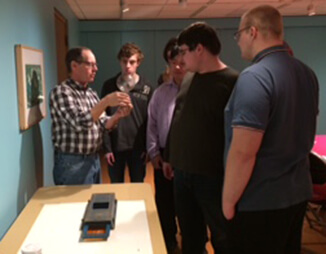Opening gallery doors, to me, is like lifting the cover of a book and revealing the story inside. I imagine gallery magic and alchemy feeding the narrative, keeping it fresh. An artwork divulges a new element . . . while I view it for the ninth time. A painting hung by a door I routinely walk through seems to reach out and grab me, demanding attention. A sculpture casts a new shadow to court my interest. Like magic tricks, visitors’ personal experiences also guide and morph the gallery story.
With this quest in mind, Dave Jones, Leigh Yawkey Woodson Art Museum facilities assistant, and I created a gallery and hands-on experience to share with a group of young men who regularly schedule visits. As a Museum educator, I research exhibition artworks and confidently present Tiffany Glass: Painting with Color and Light. As a Renaissance man, Dave draws on a wealth of knowledge and experience and adds the “cool” factor.
Dave is a studio artist who works in various mediums. He also has a penchant for collecting quirky gadgets, gizmos, and tools to incorporate in his sculptural works.
From his collection, Dave gathered items that exemplify other uses of color and light and could be incorporated into demonstrations for this group in the Museum classroom. Items included an antique lamp for viewing and exposing color-film negatives; glass bulbs from railroad-track warning signs used to reflect headlamp light; green glass insulators that once capped  transformers; and an intricately designed and painted prosthetic eyeball. And the pièce de résistance – the Spectro-Chrome device.
transformers; and an intricately designed and painted prosthetic eyeball. And the pièce de résistance – the Spectro-Chrome device.
The Spectro-Chrome is the very definition of medical  quackery. Sold in the early decades of the twentieth century, this box – with a 1,000-watt lightbulb and colored filters – promised to provide curative therapy for almost any disease. With adjustable angles and heights and a complicated prescription for color combinations, color and light therapy delivered by trained practitioners “treated” diabetes, tuberculosis, cancer, and syphilis. Spectro-Chrome sales generated great wealth for the inventor, Dinshah P. Ghadiali, until he eventually was labeled a fraud by the American Medical Association.
quackery. Sold in the early decades of the twentieth century, this box – with a 1,000-watt lightbulb and colored filters – promised to provide curative therapy for almost any disease. With adjustable angles and heights and a complicated prescription for color combinations, color and light therapy delivered by trained practitioners “treated” diabetes, tuberculosis, cancer, and syphilis. Spectro-Chrome sales generated great wealth for the inventor, Dinshah P. Ghadiali, until he eventually was labeled a fraud by the American Medical Association.
Dave’s peculiar and intriguing treasures and the gorgeous Tiffany lamps and windows fueled stimulating and delightful conversation during the group’s recent visit. Warm connections were made while creating Tiffany-inspired window transparencies.
 I can’t guarantee a Woodson Art Museum visit will miraculously cure any medical ailment, but I can promise that art shared will broaden your personal story and add an item or two to your bag of tricks.
I can’t guarantee a Woodson Art Museum visit will miraculously cure any medical ailment, but I can promise that art shared will broaden your personal story and add an item or two to your bag of tricks.
What enchanting Woodson Art Museum experience can you share?




